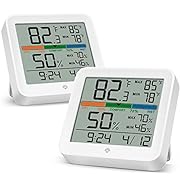For a few decades I have wrestled with black mold inside my house. The high relative humidity and copious mold in local soil makes this too easy to get established. I had a leaking bathroom toilet water fitting that was left un-repaired for years. The bathroom humidity allowed mold to do what mold does. I won't bore you with the details but the long term solution that has been successful for years is to maintain indoor relative humidity at levels low enough to suppress mold survival and spread. Coincidentally when established mold is first deprived of moisture its first reaction is to blow out huge numbers of spores. This involved lots of cleaning indoor surfaces for years.
Running indoor dehumidifiers during winter months generates excess heat that is relatively easy to live with. During summer months extra indoor heat is obviously undesirable. My research suggests that indoor humidity can be as high as 60-70% RH and still suppress mold growth. I have a few cheap indoor temperature/humidity sensors that indicate "too high" humidity for levels >55% RH. I mentally understand that I should disregard the too high humidity warnings but they serve as a subliminal "nudge" for me to dehumidify more than is necessary.

I checked and modern versions of these same gadgets have raised the "too high" thresholds to 60%RH and 70%RH.... I just ordered a pair of 70%RH threshold devices. Hopefully this will save some energy and help save the planet.
JR
Running indoor dehumidifiers during winter months generates excess heat that is relatively easy to live with. During summer months extra indoor heat is obviously undesirable. My research suggests that indoor humidity can be as high as 60-70% RH and still suppress mold growth. I have a few cheap indoor temperature/humidity sensors that indicate "too high" humidity for levels >55% RH. I mentally understand that I should disregard the too high humidity warnings but they serve as a subliminal "nudge" for me to dehumidify more than is necessary.

I checked and modern versions of these same gadgets have raised the "too high" thresholds to 60%RH and 70%RH.... I just ordered a pair of 70%RH threshold devices. Hopefully this will save some energy and help save the planet.
JR





